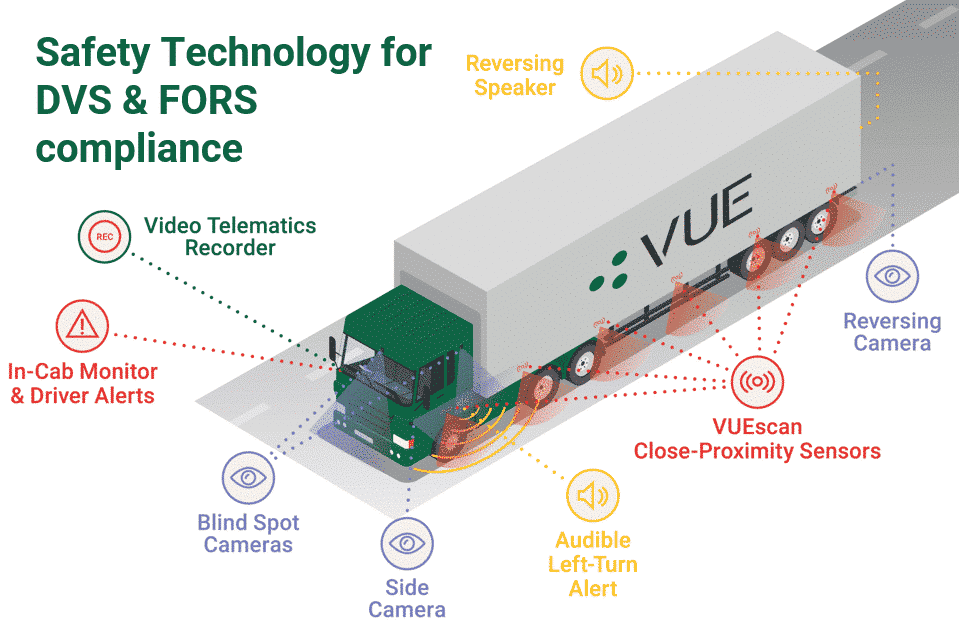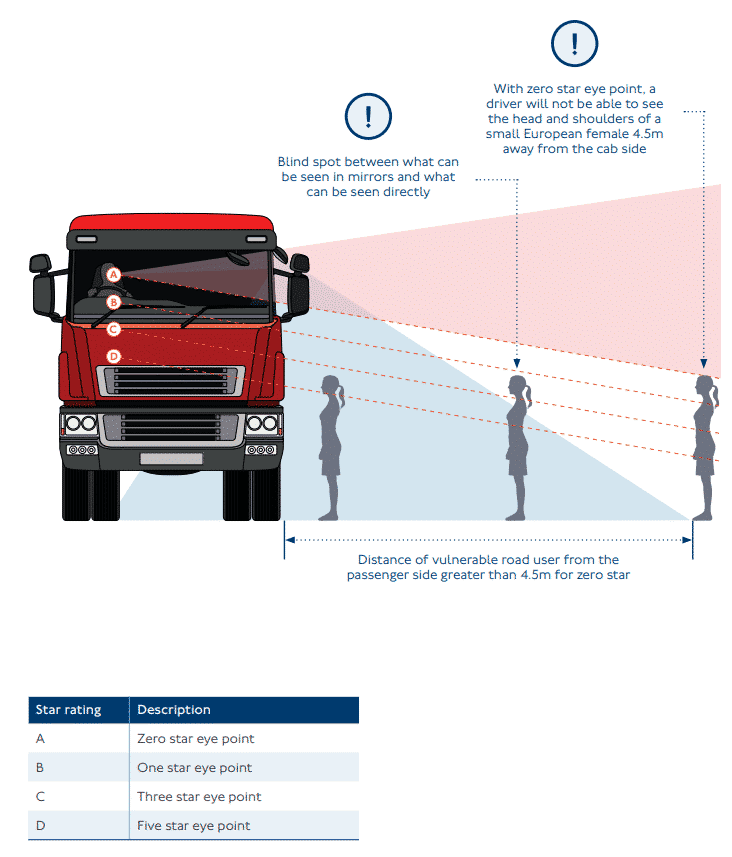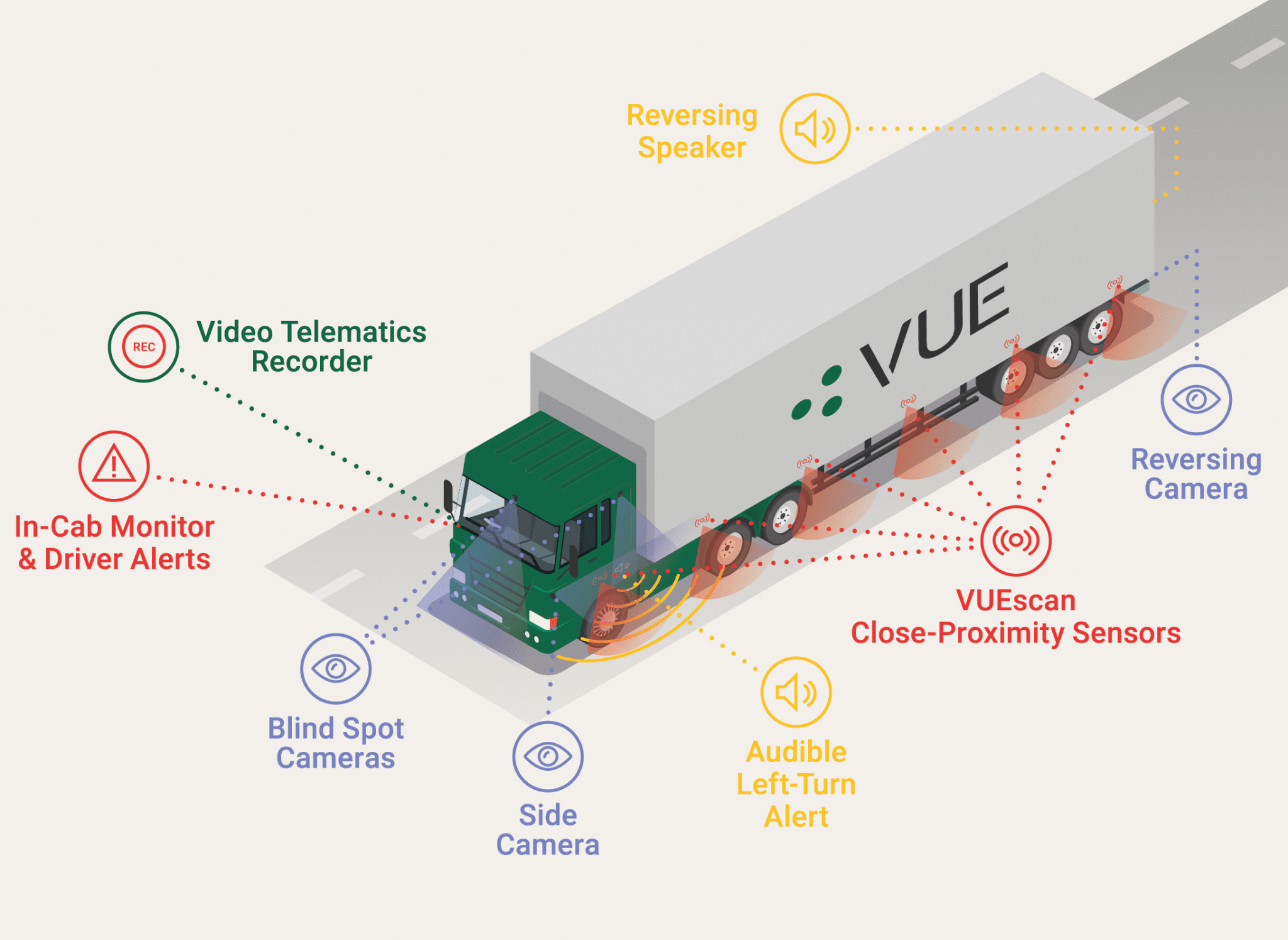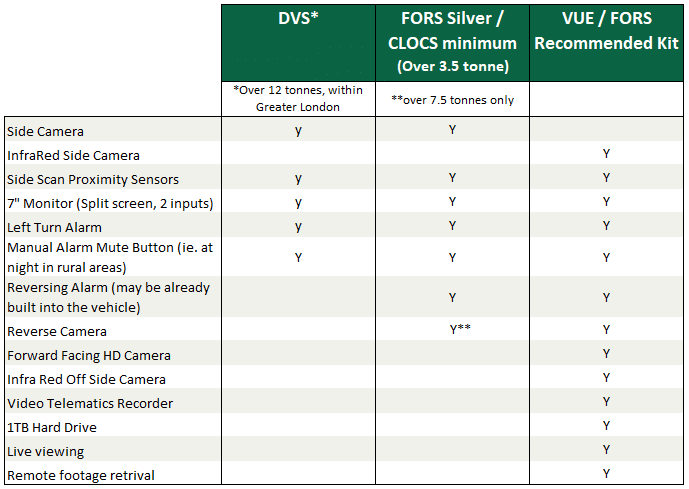From October 2024, vehicles who do not meet the minimum 3-star rating will be at risk driving in London.
Our newest DVS kit helps keep you compliant for the current and upcoming changes to the Safe System
Contact the team to discuss DVS compliancy
Glen Mullins (Managing Director of VUE) tells you everything you need to know about the Direct Vision Standard and how it affects you as an insurer or fleet manager.
The Direct Vision Standard is now in effect, and all HGVs over 12 tonnes need a Direct Vision Standard safety permit to enter or operate in the Greater London area.
Do you know the Direct Vision Standard star rating of your HGVs? Have you fitted the necessary ‘Safe Systems’ to meet DVS requirements?
If you’re already familiar with Direct Vision Standard requirements then go to our products page to browse our safety technology equipment for DVS compliance, or get in touch to book in a fitting of your DVS safe system.
However, if you’re double checking your Direct Vision Standard compliance as a fleet manager or are generally curious about DVS as an insurer, then you’ve come to the right place. I’m talking about six vital things you need to know about the DVS: what it entails, why it’s been enforced, what it means for fleet managers and insurers, and how you can plan for tightening DVS requirements in 2024.
Watch the video for an overview or read below for more details. So get reading!

1. What is the Direct Vision Standard?
Many cyclists are at risk of serious injury or worse when they ride next to the near-side (passenger side) of HGVs that are turning left. As drivers of HGVs are higher up than drivers of smaller vehicles, they can be unable to see a cyclist on their near-side and accidentally turn left or change lanes into them. The Direct Vision Standard was designed to minimise these blind spots and reduce the risk they pose.
DVS objectively measures how much a driver can see through their cab windows and mirrors, and how big the resulting blind spots are. It uses a star rating to grade HGVs from zero (lowest) to five (highest). Drivers in a zero-star vehicle will have poor direct vision and will not be able to see the head and shoulders of a pedestrian who is less than 4.5m away from the cab side. Drivers in a five-star vehicle will have good direct vision and will be able to see pedestrians, motorists and cyclists who are directly next to the cab side of their vehicles.
As an avid cyclist myself, I fully support the Direct Vision Standard and believe that it will increase the general safety of British fleets and roads. By increasing driver visibility, the Direct Vision Standard will reduce the risk of close-proximity blind spot collisions, equip drivers with the tools they need to manoeuvre safely and stop injuries to vulnerable road users. This will prevent numerous accidents and save many drivers and road users from the trauma of horrific collisions.
The Direct Vision Standard came into effect on 26 October 2020, but enforcement of the DVS standard was delayed until 1 March 2021 to give businesses more time to meet DVS requirements with all the disruption caused by COVID. However, the scheme is being updated from October 2024, with the final requirements being published in summer 2023 following a consultation period.
There’s a great diagram on page nine of the Transport for London’s (TfL) ‘HGV Safety Permit Guidance’ document which shows how the star ratings are determined.

TfL. July 2019. HGV Safety Permit Guidance [Online. Accessed 26th Sept 2019]
DVS star ratings are available from vehicle manufacturers. You should check the star ratings for your HGVs now to see if you need to take any action and implement a ‘Safe System’.
Currently, all HGVs require a one star rating to be granted a Direct Vision Standard safety permit but in October 2024 this minimum star rating will be raised to three and any vehicles that are rated a two or lower will be required to fit the Progressive Safe System to be able to obtain a permit. Transport for London are also proposing to make many elements of the current Safe System mandatory that are currently just recommendations.
The DVS ‘Safe System’ is essentially the same as the Vehicle Safety Equipment requirementsS6 from the FORS Silver accreditation (2019).
The Direct Vision Standard ‘Safe System’ includes:
– Class V and VI mirrors or cameras that eliminate blind spots around a vehicle
– A camera monitoring system including side cameras and an in-cab monitor that increase driver visibility
– Near-side proximity sensors with a driver alert that warn drivers of any vulnerable road users on their near-side
– A left-turn audible alarm that warns vulnerable road users when a vehicle indicates left
– Sideguards to reduce the chance of injury to cyclists and pedestrians
– Warning signage to warn road users of the hazards around the vehicle
Left-Hand Drive Vehicles
Left-hand drive vehicles require the same equipment and ‘Safe System’ specified above as right-hand drive vehicles. Mirrors, cameras and sensors should be fitted appropriately on left-hand drive vehicles to eliminate the blind spot located on the right-hand side of the vehicle.
FORS Silver S6 Requirements
To satisfy the FORS Silver S6 requirements, your HGVs will need to feature the equipment required for the DVS ‘Safe System’ above as well as:
– A reverse alarm to alert vulnerable road users of a reversing manoeuvre if this isn’t already built into the vehicle
– A reverse camera to give the driver a full rear view of their vehicle (if your HGV is over 7.5 tonnes)

This safety equipment satisfies the minimum requirements needed for DVS and the FORS Silver S6. However, I highly recommend that you go above the minimum standard and maximise the safety and efficiency of your fleet by fitting your vehicles with at least a 3G video telematics recorder. It’s always important to look at the type of accidents your fleet are experiencing and see what equipment will mitigate them, so you can show ROI.
Here’s our comparison of how requirements for the Direct Vision Standard and FORS Silver / CLOCS compare. Just as FORS recommends, we always suggest that you go above the minimum standard with a 3G connected recorder and a forward-facing camera.

As you’ll need time to get your rating and potentially install your ‘Safety System’, it’s best that you sort this out as soon as possible.
Remember, if your HGVs don’t have a Direct Vision Standard permit they won’t be able to operate in Greater London.
Here is a useful checklist to see if you fleet needs to become DVS compliant:

2. The Bigger Safety Picture
The Direct Vision Standard was developed by the Mayor of London (Sadiq Khan) as part of his Vision Zero initiative that aims to eliminate all deaths and serious injuries caused by road collisions from London by 2041.
It’s an initiative that I respect very much, because it recognises that road trauma causes unimaginable devastation.
In 2019, 12% of cyclists deaths across the UK were due to collisions with HGVs, even though HGVs make up only 5% of traffic in Britain. In inner London, this problem is particularly prevalent as over a three year period, HGVs were involved in over 70% of cyclists fatalities.
If you’re frustrated with the Direct Vision Standard, I encourage you to watch the stories of five road trauma victims from the TfL’s new campaign ‘Know My Name’. One man, Geoff, lost his wife of 45 years in 2012 when she was knocked off her bike and run over by a construction lorry.
If you need a strong business case for upgrading your fleet’s safety equipment, then consider how a collision could affect your drivers and colleagues too. One of the ‘Know My Name’ stories features a driver who killed a cyclist in a road traffic accident. That one event has affected her entire life, and she’s since been plagued with severe guilt that has kept her awake for many days and nights. Imagine if that was someone in your team.
A collision devastates many lives – victims, loved ones, witnesses, emergency services, but drivers, passengers and work colleagues too.
That’s why I’m completely behind the DVS and other safety schemes such as FORS and CLOCS. I believe that all fleets should aspire to be as safe as possible for the sake of everyone on the road. If you could support a scheme that reduces the chance of accidents happening, then why wouldn’t you?
3. The Direct Vision Standard for Fleet Managers
If your fleet is already compliant with FORS Silver or CLOCS, then your safety equipment meets the requirements of the Direct Vision Standard ‘Safe System’. You should apply for a DVS permit for each HGV as soon as possible, but also consider refreshing your vehicles with the latest technology to further enhance their safety.
If your fleet isn’t compliant with any other safety standards, then you’ll need to upgrade your zero-star vehicles to satisfy the DVS ‘Safe System’. But you can also use this opportunity to complete two tasks in one.
As the DVS ‘Safe System’ is essentially the same as the FORS Silver S6 safety requirements, you can upgrade your fleet with equipment that complies with both standards and start to become FORS silver compliant too. Improving your compliance ratings across the board will increase the general safety of your fleet and demonstrate that you’re a responsible employer. It’ll hopefully give you more opportunities too, as many companies now specify that their suppliers must satisfy safety schemes such as FORS or CLOCS.
Mostly importantly, you should really take the Direct Vision Standard as an opportunity to improve your fleet. The DVS doesn’t have to be a spend-to-comply exercise that’s an additional cost to your business. By upgrading your fleet with a range of safety equipment that satisfies both the DVS ‘Safe System’ and goes beyond it (such as with video telematics equipment), you can demonstrate a significant ROI and increase both efficiency and profitability for your fleet.
Just have a look at some of our case studies – Welsh Ambulance Service were able to perform live equipment tests remotely and access accurate vehicle CCTV while their vehicles were on the roads. XPO experienced the benefits of our Low Bridge Alerting System when it was trialled in their fleet.
4. The Direct Vision Standard for Insurers

The Direct Vision Standard can also benefit insurers. Increased driver visibility will help fleets decrease the likelihood of accidents and greatly reduce risk. I actually think that Britain’s roads would be a lot safer if all fleets complied with the DVS outside of London. So, I’ll take it a step further.
As a bare minimum benchmark for safety, I believe that all insurers should require their fleets to satisfy DVS requirements in their policies.
If they’d like to increase the ease of disputing claims, they should also require video telematics equipment.
Fleets that comply with the Direct Vision Standard and FORS Silver demonstrate that they take road safety seriously and are providing their drivers with the best possible tools to decrease the risk of accidents. These companies will make for better insurance policy clients and will likely save you a lot of money in the long run.
5. Choosing a DVS ‘Safe System’ Supplier
If you need to satisfy the Direct Vision Standard ‘Safe System’ or want to future-proof your fleet when the scheme is updated in October next year, then VUE can help. We have been providing industry-leading safety technology for over 20 years, and our range of hardware and software solutions will help you become compliant across a range of safety schemes.
Our range will help you meet the DVS ‘Safe System’ and includes:
– Robust and HD waterproof cameras that remove blind spots
– High-resolution LCD in-cab monitors
– VUEscan ultrasonic proximity sensors with driver alerts
Our range will also help you meet the S6 FORS Silver safety requirements, which need the DVS equipment above along with:
6. The Future of the Direct Vision Standard
Although currently you only need one star to obtain a DVS safety permit, this will rise to three stars in October 2024. As vehicles often operate on a greater than five-year lifecycle, any HGV’s bought in 2020 and beyond will need to be rated a minimum of three stars during their lifetime. It’s much easier all round to install safety equipment into a new vehicle before it joins your fleet.
When the Direct Vision Standard ‘Safe System’ is tightened in 2024, it will consider any safety technology and equipment that was not available in 2020. Zero to two star rated vehicles will need to be fitted with this new ‘Progressive Safe System’ from 2024 onwards in order to obtain a DVS permit.
We’re extremely passionate about helping fleets improve their safety and compliance ratings at VUE. Our equipment is industry-leading for a reason, and we’re already helping fleets plan ahead for 2024. Whatever the future holds, we’ll be there at the forefront.
Our equipment will help your fleet meet the Direct Vision Standard ‘Safe System’ requirements today and the ‘Progressive Safe System’ requirements in 2024 such as technology that is both retrofittable to HGV vehicles and recognised within the industry. Our innovative road safety solutions are designed to be flexible and include additional safety equipment that will help you reach different levels of compliance with FORS and CLOCS.
This article was originally published on Glen Mullins’ LinkedIn.

